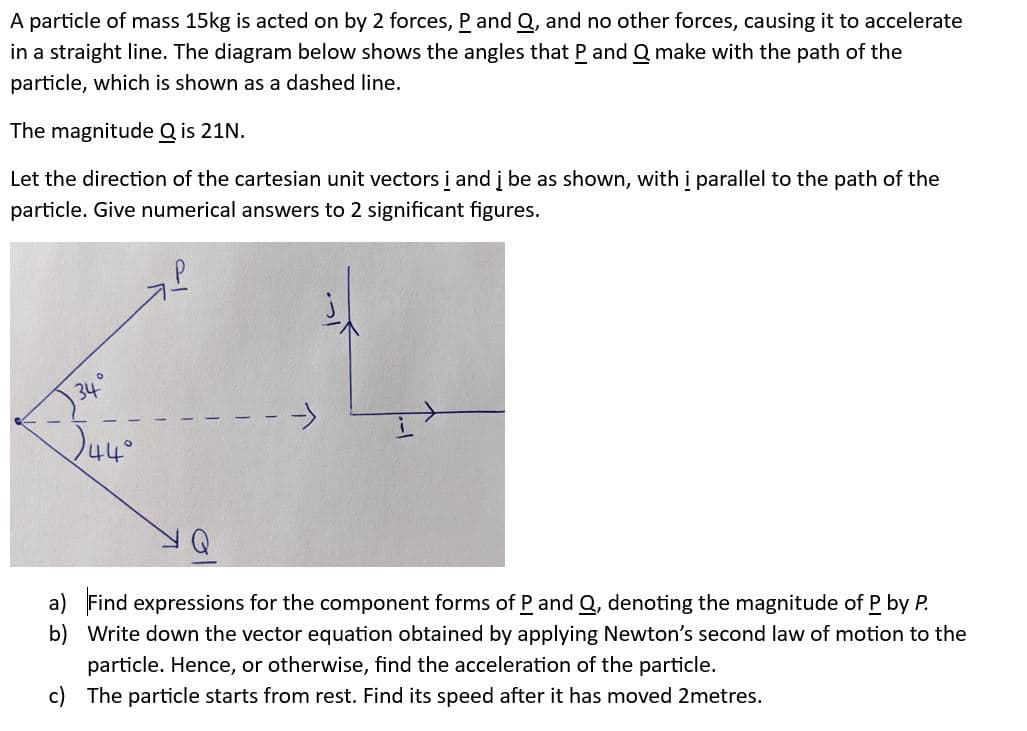A particle of mass 15kg is acted on by 2 forces, P and Q, and no other forces, causing it to accelerate in a straight line. The diagram below shows the angles that P and Q make with the path of the particle, which is shown as a dashed line. The magnitude Q is 21N. Let the direction of the cartesian unit vectors i and į be as shown, with i parallel to the path of the particle. Give numerical answers to 2 significant figures. 34 544° a) Find expressions for the component forms of P and Q, denoting the magnitude of P by P. b) Write down the vector equation obtained by applying Newton's second law of motion to the particle. Hence, or otherwise, find the acceleration of the particle. c) The particle starts from rest. Find its speed after it has moved 2metres.
A particle of mass 15kg is acted on by 2 forces, P and Q, and no other forces, causing it to accelerate in a straight line. The diagram below shows the angles that P and Q make with the path of the particle, which is shown as a dashed line. The magnitude Q is 21N. Let the direction of the cartesian unit vectors i and į be as shown, with i parallel to the path of the particle. Give numerical answers to 2 significant figures. 34 544° a) Find expressions for the component forms of P and Q, denoting the magnitude of P by P. b) Write down the vector equation obtained by applying Newton's second law of motion to the particle. Hence, or otherwise, find the acceleration of the particle. c) The particle starts from rest. Find its speed after it has moved 2metres.
Principles of Physics: A Calculus-Based Text
5th Edition
ISBN:9781133104261
Author:Raymond A. Serway, John W. Jewett
Publisher:Raymond A. Serway, John W. Jewett
Chapter10: Rotational Motion
Section: Chapter Questions
Problem 13OQ: Let us name three perpendicular directions as right, up, and toward you as you might name them when...
Related questions
Question
See attached image

Transcribed Image Text:A particle of mass 15kg is acted on by 2 forces, P and Q, and no other forces, causing it to accelerate
in a straight line. The diagram below shows the angles that P and Q make with the path of the
particle, which is shown as a dashed line.
The magnitude Q is 21N.
Let the direction of the cartesian unit vectors i and į be as shown, with i parallel to the path of the
particle. Give numerical answers to 2 significant figures.
34
44°
a) Find expressions for the component forms of P and Q, denoting the magnitude of P by P.
b) Write down the vector equation obtained by applying Newton's second law of motion to the
particle. Hence, or otherwise, find the acceleration of the particle.
c) The particle starts from rest. Find its speed after it has moved 2metres.
Expert Solution
This question has been solved!
Explore an expertly crafted, step-by-step solution for a thorough understanding of key concepts.
Step by step
Solved in 4 steps with 3 images

Follow-up Questions
Read through expert solutions to related follow-up questions below.
Follow-up Question
Thank you. What do the 3 dots in section 'b' mean and also the # notation?
Solution
Knowledge Booster
Learn more about
Need a deep-dive on the concept behind this application? Look no further. Learn more about this topic, physics and related others by exploring similar questions and additional content below.Recommended textbooks for you

Principles of Physics: A Calculus-Based Text
Physics
ISBN:
9781133104261
Author:
Raymond A. Serway, John W. Jewett
Publisher:
Cengage Learning

Classical Dynamics of Particles and Systems
Physics
ISBN:
9780534408961
Author:
Stephen T. Thornton, Jerry B. Marion
Publisher:
Cengage Learning

University Physics Volume 1
Physics
ISBN:
9781938168277
Author:
William Moebs, Samuel J. Ling, Jeff Sanny
Publisher:
OpenStax - Rice University

Principles of Physics: A Calculus-Based Text
Physics
ISBN:
9781133104261
Author:
Raymond A. Serway, John W. Jewett
Publisher:
Cengage Learning

Classical Dynamics of Particles and Systems
Physics
ISBN:
9780534408961
Author:
Stephen T. Thornton, Jerry B. Marion
Publisher:
Cengage Learning

University Physics Volume 1
Physics
ISBN:
9781938168277
Author:
William Moebs, Samuel J. Ling, Jeff Sanny
Publisher:
OpenStax - Rice University